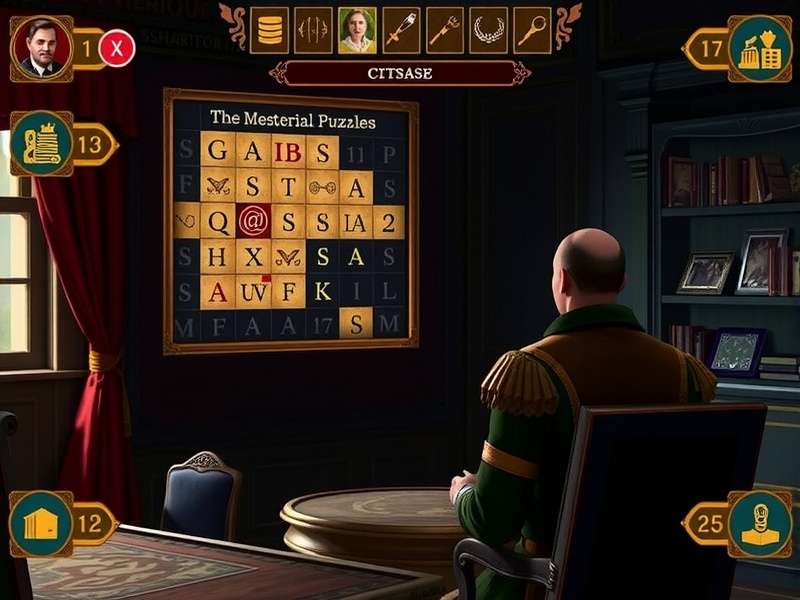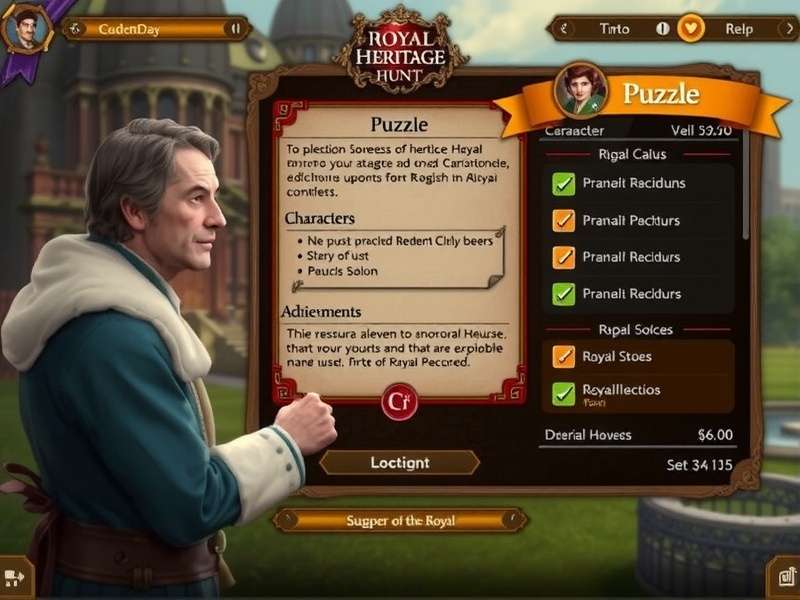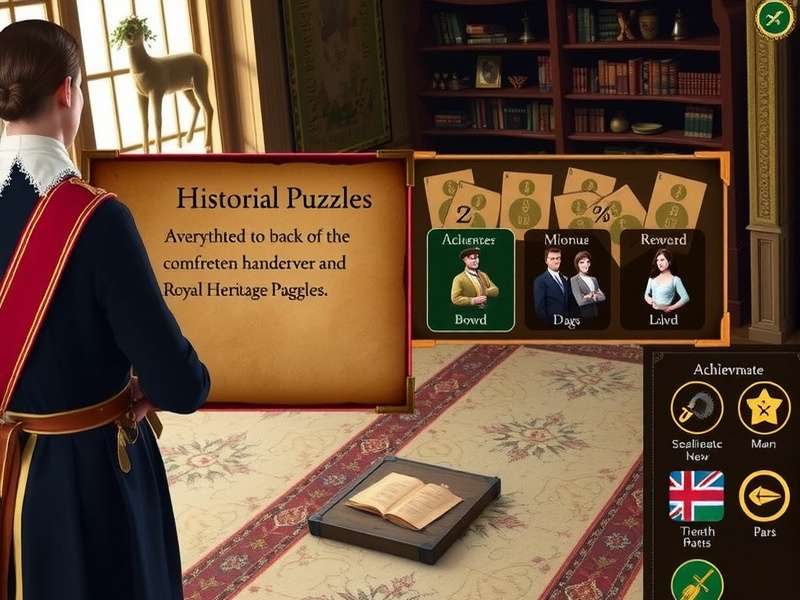Overview of Royal Heritage Hunt
Royal Heritage Huntrepresents a groundbreaking approach to cultural education and entertainment, blending traditional gaming elements with India's vast historical legacy. This innovative game transports players across the subcontinent's most iconic landmarks and hidden gems.
🎯Primary Objective:TheRoyal Heritage Huntchallenges players to solve intricate puzzles, decode ancient scripts, and navigate through historically accurate recreations of India's architectural marvels.
Developed by a team of historians, archaeologists, and game designers, this experience goes beyond typical gaming to offer genuine educational value. Each level corresponds to actual historical periods and locations, providing context about India's diverse cultural tapestry.
The game's narrative framework follows the journey of a modern-day explorer who discovers an ancient manuscript containing clues to India's greatest historical secrets. Players assume this role, embarking on what becomes the ultimateRoyal Heritage Hunt.

Core Philosophy
The creators ofRoyal Heritage Huntenvisioned a platform where entertainment and education seamlessly merge. Rather than presenting history as static facts, the game transforms historical exploration into an active, engaging adventure.
Every element—from character design to environmental details—has been meticulously researched to ensure historical accuracy while maintaining compelling gameplay mechanics that keep players invested in their cultural discovery journey.
What setsRoyal Heritage Huntapart is its commitment to authenticity. The development team collaborated with cultural organizations and historical experts to recreate environments, artifacts, and historical contexts with remarkable precision.
The game's educational components are seamlessly integrated into the gameplay rather than presented as separate lessons. Players naturally absorb information about Indian history, architecture, art, and cultural practices as they progress through the challenges.
Gameplay Mechanics
TheRoyal Heritage Huntgameplay experience is built around several core mechanics that work together to create an immersive cultural exploration adventure.
Puzzle Solving
Players encounter historically-inspired puzzles based on actual archaeological findings, ancient texts, and architectural principles.
Exploration
Navigate through beautifully rendered recreations of India's most significant historical sites and hidden cultural treasures.
Historical Research
Access in-game archives and historical documents that provide context and clues for advancing through the game.
🔍Progressive Difficulty:TheRoyal Heritage Huntcarefully scales challenge levels, beginning with simpler puzzles based on well-known historical facts and gradually introducing more complex challenges requiring deeper cultural understanding.
Each completed section of theRoyal Heritage Huntrewards players with historical artifacts for their virtual collection, along with detailed information about the significance of each item. This collection mechanic encourages completionism while reinforcing learning objectives.
The game incorporates multiple gameplay styles to maintain engagement—including point-and-click exploration, inventory-based puzzle solving, dialogue trees with historical figures, and environmental interaction challenges.
Multi-layered Narrative
The storyline ofRoyal Heritage Huntunfolds across three interconnected narrative layers: the present-day exploration, flashbacks to historical events, and mythological elements drawn from Indian epics.
This narrative structure allows players to experience history from multiple perspectives, understanding how past events influence contemporary cultural practices and beliefs throughout the Indian subcontinent.
Character development occurs through interactions with both historical figures and fictional characters representing different aspects of Indian society across various time periods.

Accessibility features ensure that theRoyal Heritage Huntremains engaging for players of different age groups and knowledge levels. Adjustable difficulty settings, hint systems, and optional historical deep-dives allow customization of the experience.
Distinctive Features
Royal Heritage Huntincorporates numerous innovative features that distinguish it from conventional gaming experiences and educational platforms.
Immersive Technologies
The game leverages cutting-edge technology to create deeply engaging experiences. Virtual reality compatibility allows players to explore historical sites in 360-degree environments, while augmented reality features bring artifacts to life in the player's physical space.
Collaborative Gameplay
Multiplayer modes enable friends and family to collaborate on solving historical mysteries. These social features encourage discussion, knowledge sharing, and collective problem-solving—mirroring how historical research often occurs in academic settings.
Multilingual Support
Recognizing India's linguistic diversity,Royal Heritage Huntoffers full localization in multiple Indian languages including Hindi, Tamil, Telugu, Bengali, and Marathi. This ensures accessibility across different regions and age groups.
Educational Integration
The game aligns with Indian educational curricula, making it a valuable supplementary learning tool. Teachers can utilize specific game modules to illustrate historical concepts and cultural practices in an engaging format.
🏆Achievement System:Royal Heritage Huntfeatures an extensive achievement system that rewards players not just for game progression, but for demonstrated historical understanding and cultural appreciation.
The dynamic content system ensures that theRoyal Heritage Huntexperience continues to evolve. Regular updates introduce new historical periods, regions, and cultural topics based on player feedback and ongoing historical research.

Cultural Accuracy & Sensitivity
A dedicated cultural review board comprising historians, anthropologists, and community representatives ensures that all content respects regional traditions and accurately represents historical contexts.
This commitment to authenticity extends to the game's audio design, which features region-specific musical compositions, historically accurate instrumentations, and voice acting by native speakers of various Indian languages.
The development team conducted extensive field research at actual heritage sites throughout India, capturing photographic references, architectural measurements, and local narratives to inform the game's environmental design.
Accessibility remains a core principle throughout theRoyal Heritage Huntdesign. The interface includes options for colorblind players, adjustable text sizes, audio descriptions for visually impaired users, and simplified control schemes for those with motor impairments.
Featured Heritage Locations
TheRoyal Heritage Hunttransports players to meticulously recreated versions of India's most significant historical and cultural sites, each selected for its unique architectural style and historical importance.
Northern Circuit
The game's northern India segment features iconic locations including the Red Fort, Taj Mahal, and Qutub Minar. Each site presents distinct puzzle types reflecting the architectural principles and historical context of the Mughal and Delhi Sultanate periods.
Players explore the intricate marble inlay work of the Taj Mahal, decode Persian inscriptions at the Red Fort, and analyze astronomical alignments at ancient observatories.
Southern Circuit
Southern Indian heritage sites highlight the Dravidian architectural tradition with elaborate temple complexes at Hampi, Mahabalipuram, and Madurai. The game mechanics here focus on understanding temple cosmology, decoding ancient Tamil scripts, and reconstructing trade route histories.
These sections emphasize the maritime history of southern kingdoms and their cultural exchanges with Southeast Asia.
Eastern Circuit
Eastern Indian locations include the Sun Temple at Konark, Buddhist monuments, and tribal heritage sites. Gameplay in these regions explores the synthesis of different religious traditions and the development of distinct regional artistic styles.
Puzzles often involve understanding mythological narratives depicted in stone carvings and tracing the influence of different philosophical schools.
Western Circuit
Western India features cave complexes at Ajanta and Ellora, stepwell architecture, and Portuguese-influenced Goan structures. These sections challenge players to understand hydro-engineering principles, analyze cave painting techniques, and trace cultural fusion in colonial-era architecture.
The gameplay emphasizes how geography influenced architectural development in different regions.
🗺️Geographical Representation:Royal Heritage Huntdeliberately includes lesser-known heritage sites alongside famous monuments to provide a more comprehensive understanding of India's diverse cultural landscape and ensure regional representation.
Each heritage location in theRoyal Heritage Huntincludes both the well-preserved monumental structures and archaeological reconstructions showing how these sites appeared at their historical peak. This dual perspective helps players understand both preservation challenges and original architectural intent.
The game's environmental storytelling techniques reveal historical narratives through subtle details—wear patterns on stone steps indicating centuries of use, architectural modifications showing changing functions, and artistic motifs tracing cultural influences across regions and time periods.
Development & Cultural Impact
The creation ofRoyal Heritage Huntrepresents a significant milestone in digital cultural preservation and educational gaming development in India.
Development began with extensive research phases involving collaboration between game designers and academic institutions including the Archaeological Survey of India, National Museum Institute, and multiple university history departments.
Technical Innovation
The game engine was custom-developed to handle the unique requirements of historical recreation—including high-detail architectural rendering, material authenticity simulation, and culturally accurate lighting conditions based on regional climatic data.
Advanced photogrammetry techniques captured precise dimensional data from actual heritage sites, while procedural generation algorithms created plausible reconstructions of partially damaged structures based on archaeological evidence.
The development team created specialized tools for historical accuracy verification, ensuring that every architectural element, material texture, and environmental detail corresponded to verified historical sources.

🌍Global Recognition:Royal Heritage Hunthas received international acclaim for its innovative approach to cultural education, receiving awards from educational technology organizations and recognition from UNESCO for promoting cultural heritage awareness.
The cultural impact ofRoyal Heritage Huntextends beyond entertainment. Educational institutions have incorporated the game into their curricula, tourism departments have reported increased interest in featured heritage sites, and cultural organizations have noted heightened public engagement with preservation efforts.
Ongoing development continues to expand theRoyal Heritage Huntuniverse with additional historical periods, regional focus areas, and gameplay innovations. Future updates plan to incorporate more interactive storytelling elements, expanded multiplayer features, and deeper integration with physical museum collections.
The success ofRoyal Heritage Hunthas inspired similar projects focusing on other aspects of Indian culture, including traditional arts, performing arts, and culinary heritage—creating what developers hope will become a comprehensive digital ecosystem for Indian cultural education and appreciation.
As technology evolves, the development team continues to explore new ways to enhance theRoyal Heritage Huntexperience—experimenting with haptic feedback for texture exploration, olfactory simulation for historical environments, and increasingly sophisticated artificial intelligence for dynamic historical character interactions.